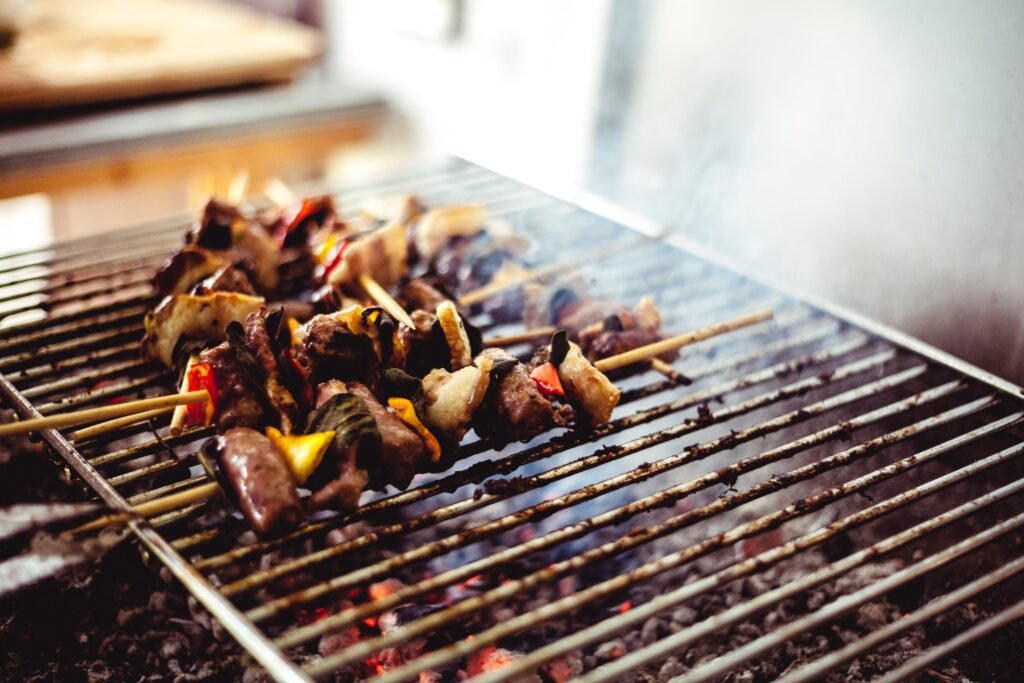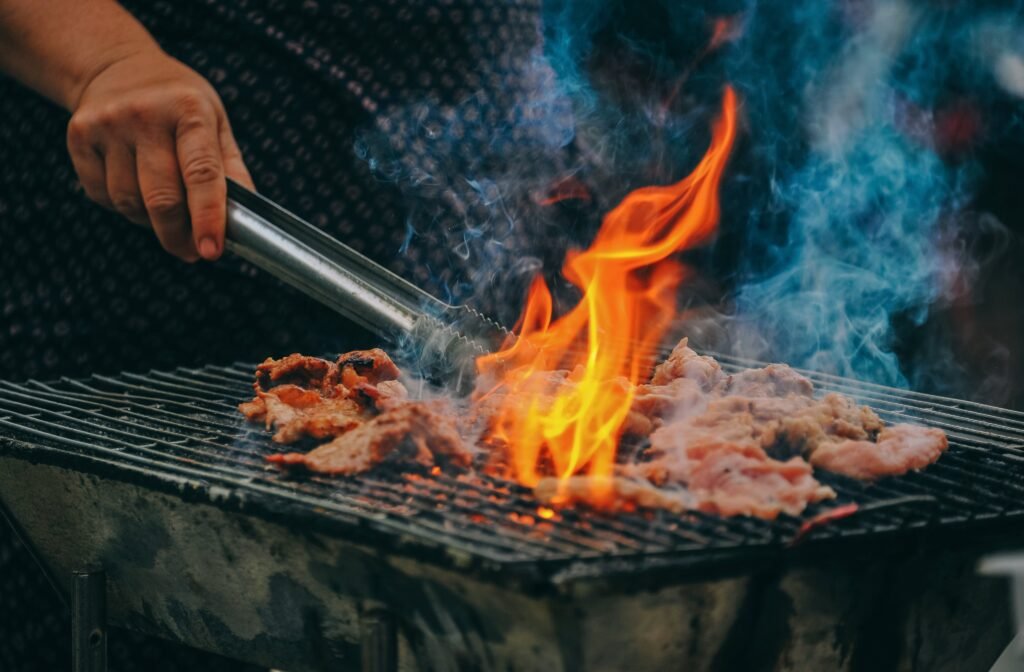Imagine the enticing aroma of smoked meat wafting through the air, tickling your taste buds and making your mouth water. If you’re an aspiring pitmaster, you may be wondering if you can achieve that smoky deliciousness by using a combination of charcoal and wood chunks. The answer is a resounding yes! By harnessing the power of both smoking methods, you can create a flavor profile that is truly out of this world. In this article, we’ll explore the art of smoking meat with charcoal and wood chunks, providing you with all the tips and tricks you need to become a backyard barbecue pro. So grab your apron and be prepared to take your grilling game to the next level!

Benefits of Smoking Meat
Enhanced flavor
One of the biggest benefits of smoking meat with charcoal and wood chunks is the enhanced flavor it imparts to the meat. The combination of charcoal and wood chunks creates a unique and smoky taste that cannot be replicated by other cooking methods. The smoke produced during the smoking process adds a rich and deep flavor profile to the meat, giving it a delicious and distinct taste that is sure to impress your taste buds.
Tenderizes meat
Smoking meat helps to tenderize it, making it juicy and flavorful. The low and slow cooking process of smoking allows the connective tissues in the meat to break down slowly, resulting in a tender and moist end product. This slow breakdown of collagen leads to a more tender and succulent texture, making smoking an excellent choice for tougher cuts of meat. Whether it’s a brisket or a rack of ribs, smoking can transform even the toughest cuts into melt-in-your-mouth delicacies.
Preservation
Another advantage of smoking meat is its ability to preserve it for a longer duration. In the past, smoking was used as a means of preserving meat before the invention of refrigeration. Smoking helps to dry out the meat and create an environment that is unfavorable for the growth of bacteria, allowing the meat to last for a longer time. While modern refrigeration methods have replaced this necessity, the preservation aspect of smoking still holds its value, especially when camping or during extended outdoor activities.
Choosing Charcoal and Wood Chunks
Types of charcoal
When selecting charcoal for smoking, it is important to choose the right type to achieve the desired flavors. There are two common types of charcoal: briquettes and lump charcoal. Briquettes are made by compressing charcoal dust and other additives into uniform shapes. They tend to burn longer and provide a more consistent heat. Lump charcoal, on the other hand, is made from natural hardwood and produces a hotter and more intense heat. It burns faster but can provide a more authentic smoky flavor.
Types of wood chunks
Wood chunks play a crucial role in adding smoky flavors to the meat during the smoking process. Different types of wood impart different flavors, so it is essential to choose the right wood chunks for your desired taste. Popular wood choices for smoking include hickory, mesquite, apple, cherry, and oak. Each wood variety adds a unique flavor profile to the meat, allowing you to experiment and find your favorite combination.
Preparing Charcoal and Wood Chunks
Soaking wood chunks
Before using wood chunks in the smoking process, it is recommended to soak them in water. Soaking the wood chunks helps to prevent them from burning too quickly and producing an intense, harsh smoke. Instead, soaked wood chunks smolder slowly, generating a mild and flavorful smoke that delicately infuses the meat. Soak the wood chunks for a few hours or overnight before using them for smoking.
Starting the charcoal
To properly smoke meat, it is essential to start the charcoal correctly. Begin by arranging the charcoal in a pyramid-shaped pile in the grill or smoker, leaving room for air and ventilation. Using a chimney starter or lighter fluid, ignite the charcoal and allow it to burn until it reaches a consistent temperature. Once the charcoal is evenly lit and no longer producing excessive smoke, it is ready to be used for smoking.
Setting Up the Grill
Direct vs. indirect heat
When setting up the grill for smoking, it is important to understand the difference between direct and indirect heat. Direct heat refers to placing the meat directly above the heat source, while indirect heat involves positioning the meat away from the heat source, allowing for a slower and more even cooking process. For smoking, indirect heat is preferred to achieve the low and slow cooking required to infuse the meat with smoky flavors.
Creating smoke
Smoking is all about creating that perfect amount of smoke to enhance the flavor of the meat. To create smoke, simply place soaked wood chunks on top of the charcoal in your grill or smoker. The heat from the charcoal will slowly ignite the wood chunks, releasing flavorful smoke that will envelop your meat. It is important to maintain a steady flow of smoke throughout the smoking process to ensure the meat absorbs the desired amount of smoky goodness.

Prepping the Meat
Choosing the meat
Choosing the right meat for smoking is crucial in achieving delicious results. Certain cuts of meat work better with smoking due to their fat content and connective tissues. Popular choices for smoking include beef brisket, pork shoulder, ribs, chicken, and salmon. These cuts benefit from the long, slow cooking process of smoking, resulting in tender and flavorful meat that is sure to impress.
Seasoning
Before smoking the meat, it is essential to season it properly to enhance its flavors. Create a dry rub or marinade using spices, herbs, and other ingredients to infuse the meat with additional layers of taste. Common seasonings for smoked meat include salt, pepper, garlic powder, paprika, brown sugar, and various herbs and spices. Use your creativity and experiment with different combinations to find the perfect flavor profile that suits your preferences.
Smoking Techniques
Hot smoking
Hot smoking involves cooking the meat at temperatures between 225-275°F (107-135°C) for an extended period. This method cooks the meat thoroughly while simultaneously infusing it with smoky flavors. Hot smoking is ideal for larger cuts of meat that require a longer cooking time, such as brisket or pork shoulder. The slow cooking process at lower temperatures allows the flavors to develop fully and creates a tender end product.
Cold smoking
Cold smoking is a method that imparts a delicate smoky flavor to the meat without fully cooking it. This technique is typically used for foods like cheese, fish, or bacon but can also be applied to meats. Cold smoking is done at temperatures below 90°F (32°C) and requires an extended smoking time. It is crucial to keep the temperature low enough to avoid cooking the meat while still infusing it with a pleasing smoky aroma.

Monitoring the Smoking Process
Temperature control
Maintaining a consistent temperature is vital when smoking meat. Invest in a reliable meat thermometer to monitor the internal temperature of the meat accurately. This will help you ensure the meat is cooking at the desired temperature and remains within the safe cooking range. Keep an eye on the grill or smoker’s temperature and adjust the airflow accordingly to maintain a steady heat throughout the smoking process.
Checking for doneness
While smoking meat, it is crucial to check for doneness to avoid undercooking or overcooking. Use a meat thermometer to assess the internal temperature of the meat, as different cuts require varying levels of doneness. For example, pork and poultry should reach an internal temperature of 165°F (74°C), while beef should reach a temperature of 145°F (63°C) for medium-rare. Regularly monitor the meat’s temperature and make adjustments as needed to achieve the desired level of doneness.
Tips for Smoking with Charcoal and Wood Chunks
Prolonging the smoke
To prolong the smoking process and ensure a consistent flow of smoke, add wood chunks or chips to the charcoal regularly. This will help maintain the flavorful smoke throughout the cooking time, preventing it from dissipating too quickly. Plan ahead and have additional wood chunks on hand to replenish the smoking material when needed.
Adding moisture
Smoking can dry out the meat, so it is essential to add moisture to enhance its tenderness and juiciness. Place a water pan in the smoker to create an environment with higher humidity, preventing the meat from drying out. Additionally, you can spray the meat with a mixture of water, juice, or marinade throughout the smoking process to add moisture and prevent it from becoming too dry.
Common Mistakes to Avoid
Using too much wood
While wood chunks are essential for smoking, using too much can overpower the meat with an excessive smoky flavor. It is crucial to find the right balance and use wood chunks sparingly to avoid an overwhelming taste. Start with a small amount and gradually add more if necessary, adjusting based on personal preference.
Rushing the process
Smoking is a slow and patient process, and rushing it can result in subpar results. It is essential to allocate enough time for the meat to cook at the desired temperature, allowing the flavors to develop fully. Remember, the low and slow cooking method is what makes smoking so special, resulting in tender and flavorful meat that is worth the wait.
Safety Precautions
Fire safety
When smoking with charcoal and wood chunks, it is important to prioritize fire safety. Ensure that the grill or smoker is placed in a safe location away from flammable materials. Have a fire extinguisher nearby and never leave the grill unattended while it’s lit. Additionally, always follow the manufacturer’s guidelines and recommendations for your specific grill or smoker to ensure safe operation.
Avoiding cross-contamination
Cross-contamination is a significant concern when handling raw meat. To prevent the spread of bacteria, always sanitize cutting boards, utensils, and other surfaces that come into contact with the raw meat. Use separate tools and containers for raw and cooked meat to avoid any potential contamination. And remember to wash your hands thoroughly before and after handling raw meat to maintain proper hygiene.
By following these guidelines and tips, you can confidently smoke meat using charcoal and wood chunks, achieving delicious, tender, and flavorful results that will impress your friends and family. Enjoy the smoky journey and savor the mouthwatering rewards of your smoked creations!
